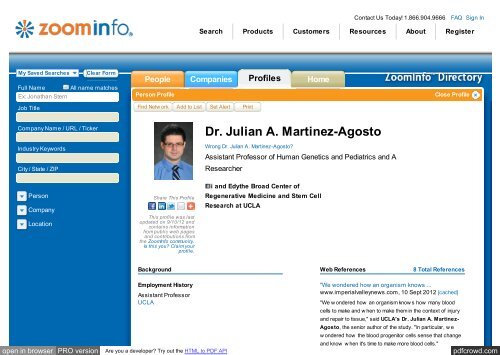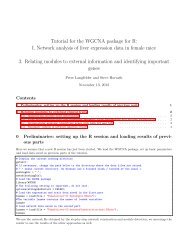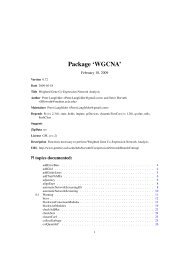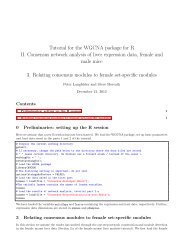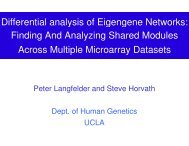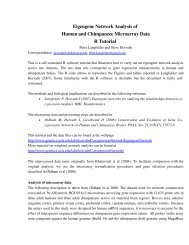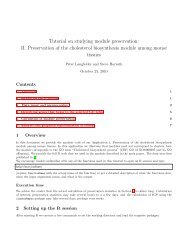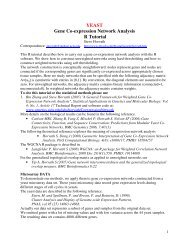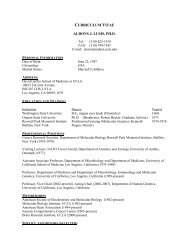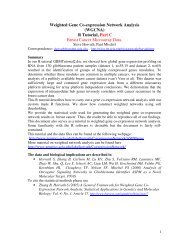ZoomInfo - UCLA Human Genetics
ZoomInfo - UCLA Human Genetics
ZoomInfo - UCLA Human Genetics
Create successful ePaper yourself
Turn your PDF publications into a flip-book with our unique Google optimized e-Paper software.
Contact Us Today! 1.866.904.9666 FAQ Sign In<br />
Search Products Customers Resources About Register<br />
My Saved Searches Clear Form<br />
Full Name All name matches<br />
Ex: Jonathan Stern<br />
Job Title<br />
People Companies Profiles Home<br />
Person Profile<br />
Find Netw ork Add to List Set Alert Print<br />
Close Profile<br />
Company Name / URL / Ticker<br />
Industry Keywords<br />
City / State / ZIP<br />
Dr. Julian A. Martinez-Agosto<br />
Wrong Dr. Julian A. Martinez-Agosto<br />
Assistant Professor of <strong>Human</strong> <strong>Genetics</strong> and Pediatrics and A<br />
Researcher<br />
Person<br />
Company<br />
Location<br />
Share This Profile<br />
This profile was last<br />
updated on 9/10/12 and<br />
contains information<br />
from public web pages<br />
and contributions from<br />
the <strong>ZoomInfo</strong> community.<br />
Is this you Claim your<br />
profile.<br />
Eli and Edythe Broad Center of<br />
Regenerative Medicine and Stem Cell<br />
Research at <strong>UCLA</strong><br />
Background<br />
Web References<br />
8 Total References<br />
open in browser PRO version<br />
Employment History<br />
Assistant Professor<br />
<strong>UCLA</strong><br />
Are you a developer Try out the HTML to PDF API<br />
"We wondered how an organism knows ...<br />
www.imperialvalleynews.com, 10 Sept 2012 [cached]<br />
"We w ondered how an organism know s how many blood<br />
cells to make and w hen to make them in the context of injury<br />
and repair to tissue," said <strong>UCLA</strong>'s Dr. Julian A. Martinez-<br />
Agosto, the senior author of the study. "In particular, w e<br />
w ondered how the blood progenitor cells sense that change<br />
and know w hen it's time to make more blood cells."<br />
pdfcrowd.com
open in browser PRO version<br />
Are you a developer Try out the HTML to PDF API<br />
and know w hen it's time to make more blood cells."<br />
To answ er this question, Martinez-Agosto, an assistant<br />
professor of human genetics and pediatrics and a researcher<br />
w ith the Eli and Edythe Broad Center of Regenerative<br />
Medicine and Stem Cell Research at <strong>UCLA</strong>, and his<br />
colleagues examined a signaling pathw ay called TOR that the<br />
cells use to gauge nutrition levels and stress.<br />
"We found that the TOR pathw ay uses these tw o genes to<br />
regulate its function and, w hen activated, it expands or<br />
increases the number of blood progenitor cells in the fly's<br />
blood," Martinez-Agosto said.<br />
...<br />
The precursors, Martinez-Agosto said, w ere producing<br />
ROS all the time, and w hen TOR w as activated, the levels<br />
increased dramatically. Too much ROS caused them to divide<br />
more than normal. The researchers found that if they treated<br />
the flies w ith antioxidants, w hich reduce ROS levels, the cells<br />
w ould develop normally.<br />
The finding could be important because the TOR pathw ay is<br />
abnormally activated in many cancers, and it may be possible<br />
to target the levels of ROS, w hich may help regulate the<br />
pathw ay.<br />
"What this study may be telling us is that too much ROS is<br />
causing more cells to divide, and w e may be able to target<br />
therapies that reduce ROS to significantly improve the<br />
condition," Martinez-Agosto said, adding that specifically<br />
targeted antioxidants might be a potential treatment in certain<br />
subsets of blood disorders.<br />
"Sometimes that pathw ay is w orking more than it should, and<br />
w e need the right amount of ROS for balance," he said. "It's<br />
like Goldilocks - there can't be too little or too much. We need it<br />
just right."<br />
Going forw ard, Martinez-Agosto and his team w ill try to<br />
determine w here the ROS are coming from and perhaps<br />
discover an enzyme that may be a good target for<br />
therapeutics.<br />
Julian A. ...<br />
www.newsroom.ucla.edu, 6 Sept 2012 [cached]<br />
pdfcrowd.com
open in browser PRO version<br />
Are you a developer Try out the HTML to PDF API<br />
Julian A. Martinez-Agosto<br />
...<br />
Julian Martinez-Agosto <strong>UCLA</strong> stem cell scientists have<br />
found that tw o common tumor-suppressor genes - TSC and<br />
PTEN - are vital to regulating the stem cell-like precursor cells<br />
that create the blood supply in Drosophila, the common fruit<br />
fly. "We w ondered how an organism know s how many blood<br />
cells to make and w hen to make them in the context of injury<br />
and repair to tissue," said <strong>UCLA</strong>'s Dr. Julian A. Martinez-<br />
Agosto, the senior author of the study. "In particular, w e<br />
w ondered how the blood progenitor cells sense that change<br />
and know w hen it's time to make more blood cells." To<br />
answ er this question, Martinez-Agosto, an assistant<br />
professor of human genetics and pediatrics and a researcher<br />
w ith the Eli and Edythe Broad Center of Regenerative<br />
Medicine and Stem Cell Research at <strong>UCLA</strong>, and his<br />
colleagues examined a signaling pathw ay called TOR that the<br />
cells use to gauge nutrition levels and stress. "We found that<br />
the TOR pathw ay uses these tw o genes to regulate its<br />
function and, w hen activated, it expands or increases the<br />
number of blood progenitor cells in the fly's blood," Martinez-<br />
Agosto said.<br />
...<br />
The precursors, Martinez-Agosto said, w ere producing<br />
ROS all the time, and w hen TOR w as activated, the levels<br />
increased dramatically. Too much ROS caused them to divide<br />
more than normal. The researchers found that if they treated<br />
the flies w ith antioxidants, w hich reduce ROS levels, the cells<br />
w ould develop normally. The finding could be important<br />
because the TOR pathw ay is abnormally activated in many<br />
cancers, and it may be possible to target the levels of ROS,<br />
w hich may help regulate the pathw ay. "What this study may<br />
be telling us is that too much ROS is causing more cells to<br />
divide, and w e may be able to target therapies that reduce<br />
ROS to significantly improve the condition," Martinez-<br />
Agosto said, adding that specifically targeted antioxidants<br />
might be a potential treatment in certain subsets of blood<br />
disorders. "Sometimes that pathw ay is w orking more than it<br />
should, and w e need the right amount of ROS for balance," he<br />
said. "It's like Goldilocks - there can't be too little or too much.<br />
We need it just right." Going forw ard, Martinez-Agosto and<br />
pdfcrowd.com
open in browser PRO version<br />
Are you a developer Try out the HTML to PDF API<br />
his team w ill try to determine w here the ROS are coming from<br />
and perhaps discover an enzyme that may be a good target<br />
for therapeutics.<br />
...<br />
Julian A. Martinez-Agosto<br />
...<br />
Julian A. Martinez-Agosto<br />
...<br />
Julian A. Martinez-Agosto<br />
Top <strong>UCLA</strong> New s<br />
The researchers examined a signaling ...<br />
www.eurekalert.org, 5 Sept 2012 [cached]<br />
The researchers examined a signaling pathw ay called TOR<br />
that the cells use to gauge nutrition levels and stress, said<br />
study senior author Dr. Julian A. Martinez-Agosto, an<br />
assistant professor of human genetics and pediatrics and a<br />
researcher w ith the Eli and Edythe Broad Center of<br />
Regenerative Medicine and Stem Cell Research at<br />
<strong>UCLA</strong>.<br />
"We w ondered how an organism know s how many blood<br />
cells to make and w hen to make them in the context of injury<br />
and repair to tissue. In particular, w e w ondered how the<br />
blood progenitor cells sense that change and know w hen it's<br />
time to make more blood cells," Martinez-Agosto said.<br />
...<br />
The precursors, Martinez-Agosto said, w ere producing<br />
ROS all the time and w hen TOR w as activated, the levels<br />
increased dramatically. Too much ROS caused them to divide<br />
more than normal. If they treated the flies w ith antioxidants,<br />
w hich reduce ROS levels, the cells w ould develop normally.<br />
The finding could be important because the TOR pathw ay is<br />
abnormally activated in many cancers, and it may be possible<br />
to target the levels of ROS, w hich may help regulate the<br />
pathw ay.<br />
"What this study may be telling us is that too much ROS is<br />
causing more cells to divide and w e may be able to target<br />
therapies that reduce ROS to significantly improve the<br />
condition," Martinez-Agosto said, adding that specifically<br />
pdfcrowd.com
open in browser PRO version<br />
Are you a developer Try out the HTML to PDF API<br />
targeted antioxidants might be a potential treatment in certain<br />
subsets of blood disorders. "Sometimes that pathw ay is<br />
w orking more than it should, and w e need the right amount of<br />
ROS for balance. It's like Goldilocks, there can't be too little or<br />
too much. We need it just right."<br />
Going forw ard, Martinez-Agosto and his team w ill try to<br />
determine w here the ROS is coming from and perhaps<br />
discover an enzyme that may be a good target for<br />
therapeutics.<br />
"The cells in the niche provide ...<br />
newsroom.ucla.edu, 4 Jan 2012 [cached]<br />
"The cells in the niche provide a safe environment to support<br />
blood progenitor cells," said co-senior author Dr. Julian A.<br />
Martinez-Agosto, an assistant professor of human genetics<br />
and pediatrics and a researcher w ith the Eli and Edythe<br />
Broad Center of Regenerative Medicine and Stem Cell<br />
Research at <strong>UCLA</strong>. "When the blood progenitor cells receive<br />
signals from the niche cells, it creates an environment for<br />
those cells to maintain their potential and not differentiate."<br />
Previous studies have show n that w hen niche cells are<br />
removed, blood progenitor cells differentiate unchecked.<br />
Ultimately, the fruit fly runs out of progenitor cells and is not<br />
able to make new cells to mount an immune response to<br />
infection or injury, Martinez-Agosto said. Martinez-<br />
Agosto and co-senior author Utpal Banerjee, a Broad Center<br />
researcher and the Irving and Jean Stone Professor and<br />
chairman of molecular, cell and developmental biology in the<br />
<strong>UCLA</strong> Division of Life Sciences, identified the additional<br />
signals coming from the daughter blood cells - a surprising<br />
discovery, Banerjee said.<br />
...<br />
Martinez-Agosto and Banerjee noted in the four-year study<br />
that once the progenitors cells had begun differentiating and<br />
the blood cells they w ere creating became mature, the<br />
progenitors became very quiescent and did not multiply.<br />
...<br />
And it requires a delicate balance - just enough signaling to<br />
give you more blood cells but not so much that all the<br />
progenitor cells are lost," Martinez-Agosto said. "Maybe<br />
other progenitors or stem cells are using the same signaling to<br />
pdfcrowd.com
open in browser PRO version<br />
Are you a developer Try out the HTML to PDF API<br />
determine w hen to differentiate or not." The team used the<br />
fruit fly because it is a very accessible model organism in<br />
w hich genes can be easily manipulated and their effects on<br />
cells monitored, Martinez-Agosto said.<br />
"The cells in the niche provide ...<br />
www.eurekalert.org, 22 Dec 2011 [cached]<br />
"The cells in the niche provide a safe environment to support<br />
blood progenitor cells," said study co-senior author Dr. Julian<br />
A. Martinez-Agosto, an assistant professor of human<br />
genetics and pediatrics and a researcher w ith the Eli and<br />
Edythe Broad Center of Regenerative Medicine and<br />
Stem Cell Research at <strong>UCLA</strong>. "When the blood progenitor<br />
cells receive signals from the niche cells it creates an<br />
environment for those cells to maintain their potential and not<br />
differentiate."<br />
Previous studies have show n that w hen you remove the<br />
niche cells, the blood progenitor cells differentiate unchecked.<br />
Ultimately, the fruit fly runs out of blood progenitor cells and is<br />
not able to make new blood cells to mount an immune<br />
response to infection or injury, Martinez-Agosto said.<br />
The new findings by Martinez-Agosto and study co-senior<br />
author Utpal Banerjee, a Broad center researcher and the<br />
Irving and Jean Stone Professor and chairman of molecular,<br />
cell and developmental biology in Life Sciences, identified<br />
additional signals not coming from the niche cells.<br />
...<br />
Martinez-Agosto and Banerjee noted in the four-year study<br />
that once the progenitors cells had begun differentiating and<br />
the blood cells they w ere creating became mature, the<br />
progenitors became very quiescent, or quiet, and did not<br />
multiply.<br />
...<br />
And it requires a delicate balance - just enough signaling to<br />
give you more blood cells, but not so much that all the<br />
progenitor cells are lost," Martinez-Agosto said. "Maybe<br />
other progenitors or stem cells are using the same signaling to<br />
determine w hen to differentiate or not."<br />
The team used the fruit fly because it is a very accessible<br />
model organism in w hich genes can be easily manipulated and<br />
pdfcrowd.com
their effects on cells monitored, Martinez-Agosto said.<br />
View All Web References >><br />
Person Profile<br />
FIND PEOPLE & COMPANIES<br />
WHAT IS ZOOMINFO<br />
<strong>ZoomInfo</strong> Database<br />
Privacy Center<br />
RESOURCES<br />
<strong>ZoomInfo</strong> Blog<br />
New sletter<br />
Webinars<br />
White papers<br />
Claim Your <strong>ZoomInfo</strong> Profile<br />
WHO USES ZOOMINFO<br />
Individuals<br />
Sales Professionals<br />
Recruiters<br />
Marketers<br />
Market Researchers<br />
Media, Bloggers and Analysts<br />
Enterprise-class Teams<br />
PRODUCTS<br />
<strong>ZoomInfo</strong>® Directory<br />
<strong>ZoomInfo</strong>® Community Edition<br />
<strong>ZoomInfo</strong>® Professional Edition<br />
<strong>ZoomInfo</strong>® CRM<br />
<strong>ZoomInfo</strong>® Data-On-Demand<br />
<strong>ZoomInfo</strong>® Enterprise<br />
PARTNERS<br />
ABOUT ZOOMINFO<br />
Careers<br />
Privacy<br />
Terms & Conditions<br />
Contact Us<br />
Concept Map<br />
CUSTOMER SUPPORT<br />
Customer Support Center<br />
My Account<br />
Register<br />
Subscribe<br />
Am I in <strong>ZoomInfo</strong><br />
Copyright © 2012 Zoom Information, Inc. All rights reserved<br />
Pro2012_OCT_RC005.2[04] SEIDXWK-44<br />
open in browser PRO version<br />
Are you a developer Try out the HTML to PDF API<br />
pdfcrowd.com


